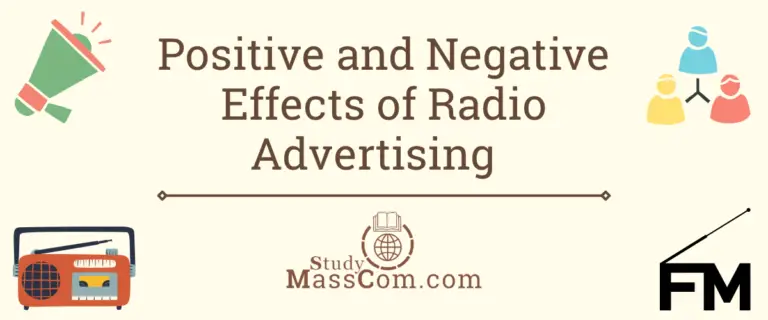Positive and Negative Effects of Advertising on Youth
Introduction
Advertising has become an inescapable part of our daily lives, bombarding us with persuasive messages through various mediums. While advertising serves as a powerful tool for businesses to promote their products and services, it also significantly influences the younger generation. This article aims to shed light on the positive and negative effects of advertising on youth, exploring both sides of the coin.

Definition of Advertising
Advertising refers to the communication and promotion of products, services, ideas, or brands to a target audience with the intention of influencing their behavior or attitudes. It is a marketing strategy employed by businesses, organizations, or individuals to create awareness, generate interest, and ultimately persuade consumers to purchase a product, adopt a service, support a cause, or change their perception about a particular offering.
Different Forms of Advertising
Advertising takes various forms to reach and engage with the target audience effectively. Here are some of the different forms of advertising:
Print Advertising
This includes advertisements in newspapers, magazines, brochures, flyers, and other printed materials. Print ads often feature visually appealing designs, persuasive copy, and relevant information to capture readers’ attention.
Television Advertising
Television commercials are a popular and impactful form of advertising. They are broadcasted during TV shows, sports events, and other programs, reaching a wide audience. TV ads combine visuals, audio, and storytelling techniques to create a memorable and persuasive message.
Radio Advertising
Radio commercials use audio content to promote products, services, or brands. They leverage music, sound effects, and voice-overs to engage listeners. Radio ads can be targeted to specific demographics based on the radio station’s audience.
Outdoor Advertising
This includes billboards, posters, transit ads, and signage placed in high-traffic locations. Outdoor advertising aims to capture the attention of people in public spaces, such as roads, bus stops, train stations, and shopping centers.
Digital Advertising
With the rise of the internet and digital platforms, digital advertising has become increasingly prominent. It encompasses various forms, including:
Display Ads
These are graphical ads that appear on websites, mobile apps, and social media platforms. They can be static images or interactive banners that capture users’ attention and drive them to take action.
Search Engine Advertising
This form of advertising involves placing ads within search engine results pages (SERPs). It targets specific keywords and displays relevant ads when users search for related terms. Pay-per-click (PPC) ads, such as Google Ads, are common in this category.
Social Media Advertising
Social media platforms like Facebook, Instagram, Twitter, and LinkedIn offer advertising options to reach their vast user bases. Advertisements can be in the form of sponsored posts, video ads, carousel ads, or influencer collaborations.
Video Advertising
Video ads are shown before, during, or after online videos on platforms like YouTube and streaming services. They can be skippable or non-skippable and range from short commercials to longer branded content.
Mobile Advertising
With the widespread use of smartphones and mobile apps, advertising has extended to mobile platforms. Mobile ads can be displayed within apps, mobile websites, or as push notifications to reach users directly on their devices.
Influencer Marketing
This form of advertising leverages the influence of popular individuals or social media personalities to promote products or brands. Influencers create content showcasing the advertised offering and share it with their followers, aiming to reach a highly engaged audience.
Content Marketing
Content marketing involves creating valuable and informative content, such as articles, blog posts, videos, or podcasts, that subtly promote a product or service. It focuses on providing value to the audience while subtly integrating promotional elements.
Direct Mail Advertising
This traditional form of advertising involves sending promotional materials directly to consumers’ mailboxes. It can include brochures, catalogs, postcards, or samples. Direct mail allows for targeted and personalized messaging.
These are just a few examples of the diverse forms of advertising available to businesses and marketers. The choice of advertising medium depends on the target audience, marketing objectives, budget, and the most effective way to convey the intended message.
Primary Objectives of Advertising
| Informing | Advertising aims to provide information about a product or service, its features, benefits, and unique selling points. It educates consumers about new offerings, updates, or changes in existing ones. |
| Persuading | Advertising seeks to persuade consumers to choose a specific brand or product over alternatives. It uses persuasive tactics like emotional appeals, social proof, and testimonials to convince potential customers of the superiority or value of the advertised offering. |
| Creating Brand Awareness | Advertising helps build brand recognition and familiarity among consumers. By repeatedly exposing the target audience to a brand name, logo, or tagline, it aims to create a strong brand presence and association in consumers’ minds. |
| Stimulating Demand | Advertising aims to generate interest and demand for a product or service. It highlights the benefits, solves problems, or addresses consumer needs to create a desire for the advertised offering. |
| Influencing Behavior | Ultimately, advertising aims to influence consumer behavior. It seeks to drive consumers to take action, such as making a purchase, subscribing to a service, or supporting a cause. |
Positive Effects of Advertising on Youth
Awareness and Education
Advertising plays a crucial role in educating young people about new products, services, and ideas. It can introduce them to social issues, environmental causes, and health initiatives. By raising awareness, advertising empowers youth with knowledge, helping them make informed choices and stay updated about various aspects of the world around them.
Inspiration and Aspiration
Well-crafted advertisements often inspire youth to dream big and pursue their goals. By showcasing successful individuals or stories of triumph, advertising can motivate young people to strive for greatness, set goals, and work hard. Advertisements featuring accomplished athletes, artists, or entrepreneurs can be particularly impactful in instilling a sense of ambition and determination.
Cultural and Social Impact
Advertising reflects societal values and can contribute to the preservation and celebration of diverse cultures. By embracing multiculturalism and inclusivity, advertisements can help young people appreciate and respect different backgrounds, fostering a more tolerant and harmonious society.
Economic Understanding
Advertisements can provide insights into the functioning of the economy, teaching youth about supply and demand, pricing, and the business world. Such exposure helps young people develop a basic understanding of economic principles and prepares them for financial decision-making in the future.
Negative Effects of Advertising on Youth
Unrealistic Beauty Standards
One of the most widely discussed negative effects of advertising is its influence on body image. Young people, especially girls, are often exposed to airbrushed and idealized portrayals of beauty, leading to body dissatisfaction, low self-esteem, and even eating disorders. Advertisements that perpetuate narrow beauty standards can have a detrimental impact on the mental and physical well-being of youth.
Materialism and Consumerism
Advertising relentlessly promotes the idea that happiness and fulfillment can be achieved through the acquisition of products. This constant bombardment can fuel materialistic tendencies among young people, fostering a culture of excessive consumption and creating a sense of dissatisfaction with what they have. Such attitudes can impact financial well-being and contribute to environmental degradation.
Influence on Decision-making
Youth are particularly vulnerable to the persuasive tactics employed in advertising. They can be easily swayed by flashy visuals, catchy slogans, and celebrity endorsements, which may lead them to make impulsive and uninformed decisions. Advertisements targeting children and teenagers often exploit their naivety and lack of critical thinking skills, potentially influencing them to adopt unhealthy habits or make poor choices.
Overexposure to Inappropriate Content
With the proliferation of digital advertising, youth are increasingly exposed to inappropriate or age-inappropriate content. Advertisements that glamorize violence, sexualize individuals, or promote harmful behaviors can negatively impact the moral and social development of young people.
Conclusion
Advertising holds both positive and negative effects on youth. While it can educate, inspire, and raise awareness, it also has the potential to reinforce harmful stereotypes, promote materialism, and exploit vulnerable demographics. It is crucial for society to strike a balance, encouraging responsible advertising practices that prioritize the well-being and empowerment of young people. Additionally, media literacy programs and critical thinking education can equip youth with the skills necessary to navigate the advertising landscape effectively and make informed choices.
FAQs
Unrealistic Beauty Standards: One of the most widely discussed negative effects of advertising is its influence on body image. Young people, especially girls, are often exposed to airbrushed and idealized portrayals of beauty, leading to body dissatisfaction, low self-esteem, and even eating disorders. Advertisements that perpetuate narrow beauty standards can have a detrimental impact on the mental and physical well-being of youth.
Materialism and Consumerism: Advertising relentlessly promotes the idea that happiness and fulfillment can be achieved through the acquisition of products. This constant bombardment can fuel materialistic tendencies among young people, fostering a culture of excessive consumption and creating a sense of dissatisfaction with what they have. Such attitudes can impact financial well-being and contribute to environmental degradation.
Influence on Decision-making: Youth are particularly vulnerable to the persuasive tactics employed in advertising. They can be easily swayed by flashy visuals, catchy slogans, and celebrity endorsements, which may lead them to make impulsive and uninformed decisions. Advertisements targeting children and teenagers often exploit their naivety and lack of critical thinking skills, potentially influencing them to adopt unhealthy habits or make poor choices.
Overexposure to Inappropriate Content: With the proliferation of digital advertising, youth are increasingly exposed to inappropriate or age-inappropriate content. Advertisements that glamorize violence, sexualize individuals, or promote harmful behaviors can negatively impact the moral and social development of young people.
Advertising employs various strategies to specifically target youth and capture their attention. Here are some ways in which advertising targets the youth demographic:
1. Appealing Visuals and Design: Advertisements aimed at youth often utilize vibrant colors, captivating visuals, and trendy designs to grab their attention. Eye-catching graphics, animated characters, and visually appealing layouts are employed to create a visually enticing experience.
2. Celebrity and Influencer Endorsements: Youth are highly influenced by their favorite celebrities and social media influencers. Advertisers leverage this by featuring popular figures in their campaigns to establish a connection and gain credibility with the target audience. Celebrity endorsements make products or services appear more desirable and relatable.
3. Social Media and Online Platforms: Youth are heavily engaged with social media platforms and spend a significant amount of time online. Advertisers take advantage of this by placing targeted ads on platforms like Instagram, Snapchat, and YouTube. These ads are often seamlessly integrated into the content they consume, increasing the chances of capturing their attention.
4. Peer Influence and User-Generated Content: Youth are heavily influenced by their peers. Advertisers encourage user-generated content and social media challenges that involve sharing experiences with a particular brand or product. This fosters a sense of participation and creates a buzz among their social circles, driving engagement and word-of-mouth promotion.
5. Mobile Advertising: Since youth are avid users of smartphones and mobile apps, advertisers focus on mobile advertising to reach them effectively. Mobile ads can appear within popular apps, mobile games, or social media feeds, enabling advertisers to connect with youth on their preferred devices.
Yes, advertisements have a significant influence on children. Children are a particularly vulnerable audience as they are more susceptible to persuasive messaging and have limited critical thinking skills. Here are some ways in which advertisements impact children:
1. Shaping Preferences and Purchase Requests: Advertisements create desires and shape children’s preferences by promoting products as fun, desirable, or essential. Children often express their desire for advertised items, putting pressure on parents to fulfill their requests.
2. Influence on Consumer Behavior: Advertisements can directly impact children’s consumer behavior. They may encourage children to seek out specific brands, products, or services, leading to increased sales and brand loyalty.
3. Formation of Attitudes and Values: Advertisements contribute to the formation of children’s attitudes, values, and beliefs. They can shape their perceptions of gender roles, body image, beauty standards, and societal norms, potentially perpetuating stereotypes and unrealistic ideals.
4. Development of Brand Awareness and Loyalty: Advertisements play a crucial role in developing brand awareness and loyalty from an early age. By repeatedly exposing children to brand logos, characters, and jingles, advertisements create a strong association between the brand and positive emotions, leading to long-term brand preferences.
5. Influence on Food Choices and Eating Habits: Food advertising heavily targets children, promoting unhealthy snacks, sugary drinks, and fast food. Such advertisements influence children’s food choices, contributing to poor dietary habits and potential health issues like obesity and related diseases.


